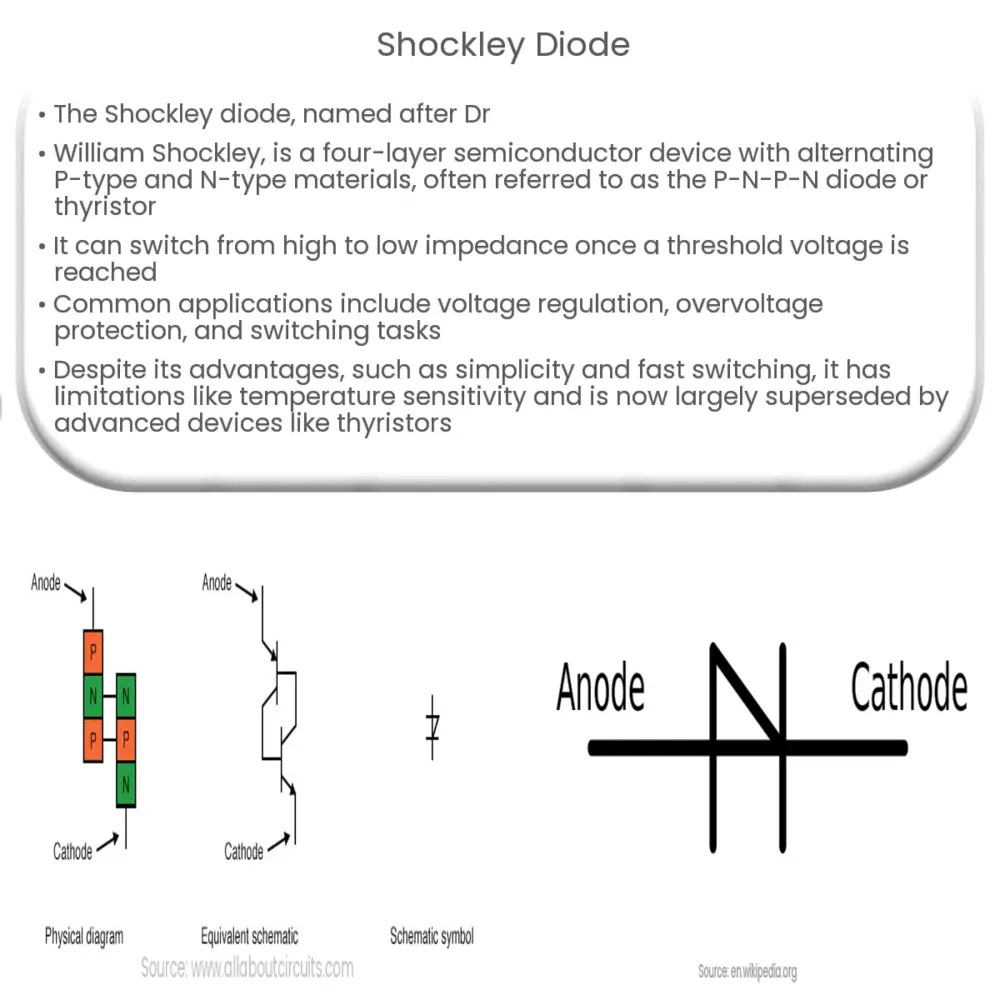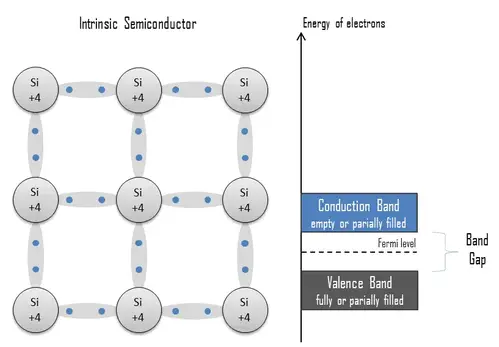The Shockley diode is a 4-layer semiconductor device with unique switching properties, used in voltage regulation and protection applications.

Introduction to the Shockley Diode
The Shockley diode, named after its inventor, Dr. William Shockley, is a semiconductor device that has a unique property of switching from a high impedance to a low impedance state once it reaches a certain threshold voltage. The diode is a four-layer semiconductor device consisting of alternating P-type and N-type materials. It is also known as the P-N-P-N diode or thyristor. In this article, we will explore the Shockley diode, its operation, applications, and how it differs from other types of diodes.
Structure and Operation of the Shockley Diode
The Shockley diode consists of four layers of semiconductor material, with alternating P-type and N-type layers, forming two back-to-back P-N junctions. The outer layers are typically heavily doped, while the inner layers are lightly doped. This arrangement results in a device that has three terminals: an anode (A), a cathode (K), and a gate (G).
Under normal conditions, the Shockley diode behaves like an insulator, with a high impedance between the anode and cathode. When a voltage is applied to the anode, the diode remains non-conducting until the voltage reaches a critical level known as the breakover voltage. At this point, the device undergoes a rapid transition from a high impedance to a low impedance state, allowing current to flow freely between the anode and cathode.
The Shockley diode remains in the conducting state until the current drops below a specific threshold known as the holding current. Once this occurs, the device reverts back to its non-conducting state, and the process can be repeated by applying a voltage that exceeds the breakover voltage.
Applications of the Shockley Diode
Thanks to its unique switching properties, the Shockley diode has found numerous applications in various electronic circuits. Some of the most common uses of the Shockley diode include:
- Voltage Regulators: The Shockley diode can be used as a voltage regulator, ensuring that the output voltage remains constant regardless of fluctuations in the input voltage. This is particularly useful in power supply circuits, where maintaining a stable output voltage is crucial.
- Overvoltage Protection: The device can act as a protective element in circuits by clamping the voltage to a specified level, preventing damage to sensitive components due to overvoltage conditions.
- Switching Applications: The Shockley diode’s ability to switch between high and low impedance states makes it suitable for various switching applications, such as triggering a relay or controlling the firing angle of a thyristor in a phase-controlled rectifier.
Advantages and Limitations of the Shockley Diode
While the Shockley diode has several advantages, it also comes with some limitations. The following are some of the key advantages and limitations of this device:
Advantages
- Simple Structure: The Shockley diode has a relatively simple structure, making it easier to manufacture compared to other semiconductor devices.
- Low Power Consumption: Due to its low conduction loss in the ON state, the Shockley diode consumes less power compared to other types of switching devices.
- Fast Switching: The Shockley diode can switch between its high and low impedance states quickly, making it suitable for high-frequency applications.
Limitations
- Low Switching Current: The holding current of a Shockley diode is relatively low, which can limit its use in high current applications.
- Temperature Sensitivity: The breakover voltage and holding current of the Shockley diode are sensitive to temperature changes, which may require additional temperature compensation circuits in some applications.
- Obsolete Technology: The Shockley diode has largely been replaced by more advanced and versatile semiconductor devices, such as thyristors and TRIACs, which offer better performance and functionality.
Comparison with Other Diodes
There are several types of diodes available, each with its unique characteristics and applications. Here, we will briefly compare the Shockley diode with some other commonly used diodes:
- Zener Diode: Zener diodes are designed to operate in the reverse-bias breakdown region, providing a stable reference voltage. While both the Zener diode and the Shockley diode can be used for voltage regulation, the Shockley diode switches between high and low impedance states, whereas the Zener diode operates continuously in the breakdown region.
- Rectifier Diode: Rectifier diodes are used for converting alternating current (AC) to direct current (DC) in power supply applications. They have a simple two-layer structure (P-N junction) and function as one-way valves for current flow. In contrast, the Shockley diode has a four-layer structure and unique switching properties that differentiate it from rectifier diodes.
- Schottky Diode: Schottky diodes are known for their low forward voltage drop and fast switching speeds, making them suitable for high-frequency applications. The Shockley diode, while also offering fast switching, has different characteristics and applications due to its four-layer structure and switching behavior.
In conclusion, the Shockley diode is a unique semiconductor device that, despite being largely replaced by more advanced components, remains an important part of the history of electronics. Its unique switching properties and various applications make it an interesting device to study and understand.



